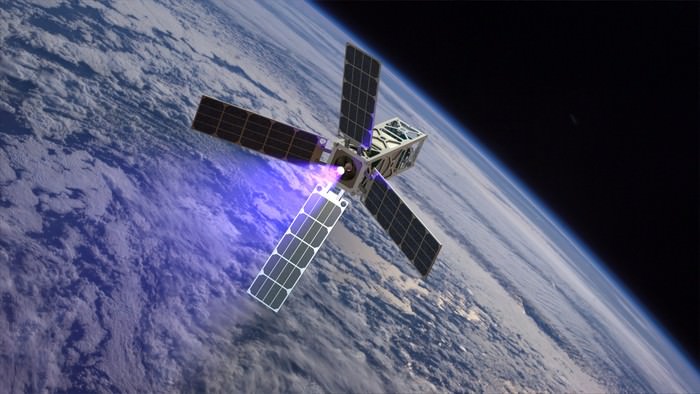Cubesats are all the rage these days: they’re usually inexpensive and quick to build and they can tag along on launches already scheduled for other things. We think of cubesats as being almost “disposable” satellites – tiny spacecraft that go into Earth orbit for a short time, do their science and then burn up harmlessly in Earth’s atmosphere. But a team of scientists have a more long-term, long-distance plan for their cubesats. Benjamin Longmier and James Cutler from the University of Michigan want to build cubesats that have tiny plasma thruster engines that could propel them into deep space, maybe even interstellar space.
They have a vision of their plasma-thruster cubesat waving as it speeds past the Voyager spacecraft at the edge of our Solar System.
They are working on what they call the CubeSat Ambipolar Thruster (CAT), a new plasma propulsion system. This thruster technology doesn’t exist all in one piece yet, but Longmeir and Cutler said they could put it together in months, with just a little funding. The CAT plasma thruster will propel a 5kg satellite into deep space, far beyond Earth orbit, at 1/1000th the cost of previous missions.
They’ve begun a $200,000 Kickstarter campaign to help fund their project. Their ideas of what these thruster propelled cubesats could do are mind-bogglingly exciting: flying through the plumes of Enceladus to look for life, studying and tagging asteroids, formation flying through Earth’s magnetosphere to learn more about solar flares and the aurora or just an interplanetary message in a bottle lasting for hundreds of millions of years in orbit around the Sun.
They think they can get a satellite up and flying within 18 months.
“The traditional funding process starts with some seed data, a large government grant and a large number of milestones and gates to go through,” said Longmier in a press release from the University of Michigan. “We’d like to leverage Kickstarter funds to compress that timeline and go from initial seed data to flight in about 18 months, a much faster time scale than is possible with traditional grants.”
The cubesats would be about as big as a loaf of bread and the thrusters – the first of its kind — would use superheated plasma directed through a magnetic field to propel the CubeSat. The duo says that with this technology, exploring interplanetary space and eventually other planets would become faster and cheaper than ever before.
While plasma rockets have been used before, they’ve only been used on big spacecraft like Deep Space 1 and DAWN. Longmier and Cutler are miniaturizing the system. Most of the thruster components have been built and have been tested individually, but they need help through Kickstarter to assemble everything into one compact thruster unit for testing the integrated components in the lab, then in Earth orbit, and then interplanetary space.
They’ve got more info on how the thrusters work on their Kickstarter page.
I dare you to tell me this isn’t exciting!
More info from the University of Michigan.

